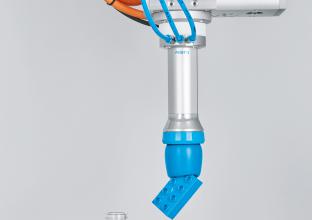
The automated chameleon tongue
Gripping workpieces just as a chameleon's tongue grips insects – that is the operating principle of the adaptive shape gripper DHEF from Festo. This unusual gripper can pick up, gather and set back down again objects of many different shapes without the need for manual adjustment.
The silicone cap of the adaptive shape gripper DHEF can fold itself over and grip objects of virtually any shape. This creates a firm, form-fitting hold. The elastic silicone enables the gripper to precisely adapt to a wide range of geometries. When combined with a pneumatic drive, the adaptive shape gripper requires little energy for a secure grip.
Formless, round, sensitive
Unlike the mechanical grippers currently available on the market that can only grip specific components, the adaptive shape gripper is extremely flexible. It can even manage components with freely formed shapes and round geometries. The absence of sharp edges makes it ideal for gripping sensitive objects such as air nozzles or trim strips. In principle, the gripper can pick up several parts in one movement, for example nuts from a bowl.
This means that the bionic gripper can be used to handle small parts in classic machine building, in the electronic or automotive industry, in supply units for packaging installations, for human-robot interaction during assembly tasks or for prosthetic extensions in medical technology.
Practical product characteristics
The gripper has an elastic silicone membrane that is flexible and pliable; once it is supplied with compressed air and the standardised robot interface with integrated air connections has been added, it is ready to be used as a practical automation component. The standard sensor slot for position sensing as well as the bayonet lock for easy replacement of the cap are additional useful features.
Nature as a model
The unique combination of force and form fitting of the chameleon's tongue can be observed when it is on the hunt for insects. Once the chameleon has its prey in its sights, its tongue shoots out like a rubber band. Just before the tip of the tongue reaches the insect, it retracts in the middle whilst the edges continue to move forwards. This allows the tongue to adapt to the shape and size of the prey and firmly enclose it. The prey sticks to the tongue and is pulled in as though caught on a fishing line. The Festo Bionic Learning Network with researchers from the University of Oslo used these observations when developing a prototype with the name "FlexShapeGripper".
费斯托 (Festo)是一家全球性的独立的家族企业,总部位于德国埃斯林根。自成立以来,Festo在工业自动化技术和技术教育方面制定标准,从而为环境、经济和社会的可持续发展做出贡献。公司为超过35个行业的30万家工厂和过程自动化客户提供气动和电驱动自动化技术解决方案,其中生命科学和实验室自动化业务受到越来越多的关注。Festo产品和服务遍布176个国家。2024年,费斯托在全球61个国家的250多个分支机构拥有约20600名员工,实现销售额34.5亿欧元。每年约8%的销售额用于研发。在这家学习型企业,1.5%的销售额用于基础和进一步培训。Festo 教学培训 (Didactic SE) 是全球领先的技术教育和培训供应商,为全球客户提供工业环境中全面的数字化和常规学习解决方案。


